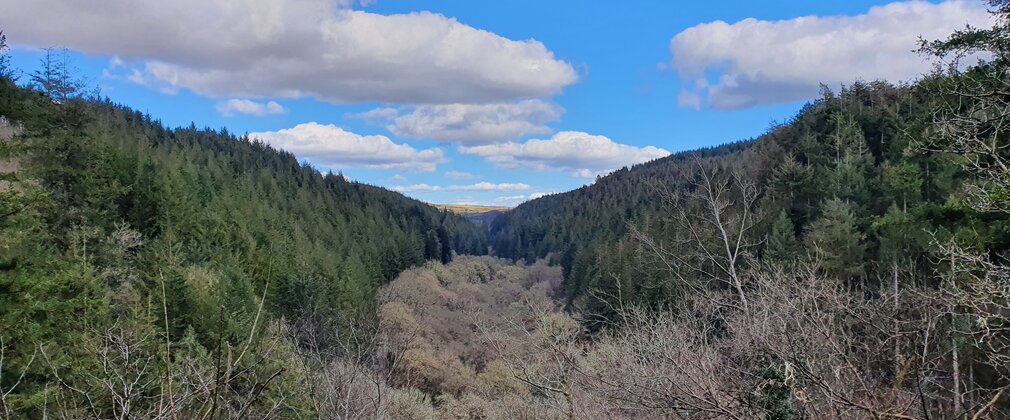Cardinham Forest Plan
A forest plan is a description of the woods or forest as it is now and what is considered when deciding what is best for the future. The forest plan describes how the forest will develop over time and gives specific information about approved tree felling, replanting and regeneration over the next ten years.
About Cardinham Woods
The Cardinham Forest Plan covers 265 hectares of the nation's forests woodland to the east of Bodmin on the southern fringes of Bodmin Moor in Cornwall. A number of individually named woods make up the public forest holding here, which includes most of Lidcutt, Deviock, Hurtstocks and Callywith woods, together with parts of Quarryhill, Tawnamoor and Margate woods.
Cardinham Woods are a rich mix of planted conifers, with pockets of native broadleaves and open ground, in the steep sided stream valleys around Cardinham Water. The view upriver to the moor from the plateau of Callywith Wood takes in mature woodland, new growth, upland pasture and open heath. The forest here is actively managed to provide valuable products for local and national markets and to improve the remaining stands for wildlife and recreation as well as timber quality.
Most of the area is classed as Ancient Woodland, the majority being Plantation on Ancient Woodland Sites. There are areas of permanent open space within the forest and along forest roads, rides and watercourses, and felled areas regenerating naturally.
Populations of the declining pearl bordered and small pearl bordered fritillary butterflies are found locally. Survey work carried out for Butterfly Conservation has identified significant opportunities to improve and extend habitat for these species within the woods, connecting areas of existing habitat in the surrounding countryside.
Several public footpaths and bridleways pass through the area, and the entire woodland is dedicated as open access land under the Countryside and Rights of Way Act.
The network of forest roads here are popular with local horse riders and four waymarked walking trails are maintained by the local team. Dedicated single track cycle trails, purpose built by the 1 South West project, cater for both moderately experienced off road cyclists and more proficient mountain bikers.
There are also car parking and toilet facilities, a picnic area, children's play area and Woods cafe on site.
Objectives of the plan
Our main aims during the life of this plan are to continue the process of restoring ancient woodland, increase resilience to climate change, pests and disease, and improve the forest for people. The objectives of management here are:
Economic objectives
- Continue sustainable management of the wood resource through the use of continuous cover systems.
- Where these systems are not viable develop resilience by diversifying age structure and species composition through clearfelling and restocking.
Environmental objectives
- Manage invasive exotic weed competition and monitor development of areas designated as successional habitat, reacting to natural processes to influence their diversity and productivity.
- Enhance the woodlands' value for nature conservation and biodiversity, continuing to move towards a greater proportion of native broadleaves over time.
- Consolidate existing managed open space and develop a matrix of open and semi-open habitat to provide wildlife corridors, particularly along rides and water courses.
Social objectives
- Conserve all cultural and heritage features, adopting appropriate mitigation measures to avoid damage.
- Maintain and enhance the internal and external wooded landscape through sympathetic coupe design.
•Maintain open access and existing facilities for formal and informal recreation. Develop opportunities to expand infrastructure through local partnership working.
What we'll do
The current plan outlines management proposals including felling and restocking over three decades, with felling licence approval for operations up until 2024.
The planned areas of clearfelling, restocking and open habitat creation during the ten years to 2024 are summarised below.
Clearfelling of 5.4ha of conifers. Restocking of 3.8ha of broadleaves. Regeneration of 1.6ha of open/successional habitat.
In addition to these defined operations, ongoing thinning and selective felling of both conifers and broadleaves will be carried out in the plan area at five to ten year intervals. There are also several previously felled areas which are expected to regenerate naturally over the plan period.
The species composition will also change from 70% conifer, 20% broadleaf, 5% open space and 5% felled area in 2014 to 63% conifer, 27% broadleaf, 3% open space, 4% felled area and 3% successional habitat in 2024.

